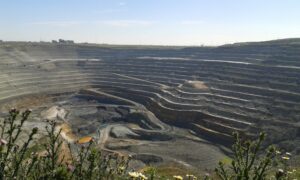On March 25, the European Commission published the list of “strategic” mining projects to be developed within the territory of the European Union, under the new Critical Raw Materials Act (CRMA) – approved in 2024. This law is intended to guarantee a secure supply of raw materials necessary for the production of low-emission technologies, within the context of the green and digital transition model promoted by the EU, with the aim of significantly reducing the EU’s dependency on other countries. This law has been presented as key to an ecological transition, but in reality, it represents an alarming acceleration of the extractivist model in Europe and across the world, with serious social and environmental consequences both locally and globally.
At SETEM, we have been working for over two years as members of the Raw Materials Coalition to influence EU policies, advocating for a socio-ecological transition model based on sufficiency, degrowth, reduced consumption and waste of resources, and social and global justice. The CRMA, far from transforming the current model based on a logic of growth, extractivism, and colonialism, consolidates and expands it, shifting the consequences of an unsustainable system onto sacrifice zones.
A Transition that Perpetuates the Problem
The “strategic” projects announced by the Commission are based on a profoundly flawed logic: instead of reducing demand and consumption of raw materials and addressing the root of the problem, they choose to redirect dependency. The new regulation does not question the unsustainable model of production and consumption that has caused the current ecological crisis—it simply perpetuates it beyond Europe’s borders, and now within them too. It does not focus on reducing demand, but on ensuring supply. This means exacerbating the impacts of extractivism in existing and new deposits in the Global South, and replicating this model now in the Iberian Peninsula. These transition policies also do not reduce extraction and exploitation of resources from the Global South; rather, they increase extractive activity in countries like Spain on the official list.
This classification of projects as “strategic” not only exempts them from basic environmental controls but also grants them fast-track approval, prioritized access to public funding, and preferential status in judicial and administrative processes. This prioritization seriously endangers biodiversity and the rights of local communities—especially when deposits are located near or within Natura 2000 areas, a European network aimed at protecting vulnerable species and habitats.
All of this has been done while ignoring warnings from experts and environmental organizations about the social and environmental impacts of these projects. This constitutes a clear violation of the Aarhus Convention, which guarantees the right to information, participation, and environmental justice.
Spain, a New Zone of Sacrifice
Spain is the European country with the most extraction mining projects on the CRMA list. Of the seven declared strategic projects, six involve the extraction of minerals like cobalt and lithium, and only one is focused on recycling. Additionally, according to a report by Amigas de la Tierra, the chosen mines have a history of poor environmental practices, such as the Las Cruces mine (Seville), La Parrilla (Cáceres), and Aguablanca (Badajoz), as well as projects that face widespread social opposition due to their expected impacts on protected areas, like Las Navas (Cáceres) and Doade (Ourense). Moreover, the Las Cruces mine has accumulated over €6.5 million in fines and compensation for illegal extraction of water from the Gerena and Guillena-Cantillana aquifers—classified as strategic emergency reserves for potable water supply in Seville in times of scarcity. Spain is the country with the most extraction projects on the list, in clear contrast with countries like Italy, France, or Germany, where most proposals focus on substitution, recycling, or processing. This reinforces the role of the Iberian Peninsula as a sacrifice zone to satisfy the material needs of the rest of the continent.
Institutional Greenwashing

To make it more palatable, this shift is framed within a narrative of ecological necessity. Citizens are told this is essential to address the climate emergency and ensure a sustainable future. But what does “sustainable” really mean? We are talking about a transition toward private electric cars, massive batteries, digital infrastructure, large-scale wind turbines—ultimately a transition model not designed from an ecological perspective and based on efficient resource use, but rather one seen as an opportunity for Europe’s reindustrialization and competitive advantage in global markets. The transition model being promoted through policies like the CRMA does not prioritize reducing the demand for critical minerals and energy; it perpetuates the same model of overproduction and consumption that brought us here.
We Advocate for a True Energy Transition
At SETEM, we emphasize that a true green and just transition cannot be based on more extraction, but on less demand. Our stance is clear: reduce mineral consumption, prioritize eco-design, reuse, repair, and recycling, and promote production and consumption models based on sufficiency and circularity.
For more information on energy transition measures see SETEM Catalunya’s video.
This approach not only reduces environmental impact and the risk of rights violations but also generates more stable and quality employment. Unlike mining—which often leaves behind destruction and unemployment once deposits are depleted—the sectors of reuse and repair offer opportunities to create sustainable jobs aligned with the EU’s climate and social goals.
The list of strategic mining projects in the Global South will be published later, and we will continue our advocacy to defend a more circular model based on reducing demand.

